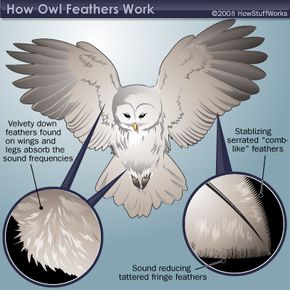Quck answer
Owls are able to fly silently thanks to several adaptations. Their feathers have fringes that reduce noise and turbulence, and their wings are designed to reduce flapping noise. They also have specialized down feathers that absorb sound and muffle vibrations. Additionally, owls have a unique skeletal structure that allows them to fly with minimal noise. These adaptations enable owls to fly quietly and hunt effectively, making them one of the most efficient predators in the animal kingdom.
Wild Animals
The Feather and Wing Structure of Owls

HowStuffWorks
The ability of owls to fly silently contributes to their mysterious and stealthy nature, which helps them to sneak up on prey. But how exactly do owls achieve silent flight?
Owls’ wings are designed in a way that allows them to fly almost silently. Different parts of their wings and feathers play a role in achieving this feat. Owls have large wings with a broad surface area that enables them to glide through the air with minimal flapping. This results in less noise.
The unique leading edges of owls’ primary feathers are the primary reason why they can fly silently. As other birds fly, turbulence is created when air rushes over their wings, which causes noise. However, owls’ wings have a unique design that reduces the noise caused by turbulence.
The primary feathers of an owl are serrated like a comb, which reduces turbulence into smaller currents known as micro-turbulences. The edge of the feather muffles the sound of air flowing over the wing and changes the angle at which air flows. This allows air to pass through the soft feathers, resulting in no sound. Some experts believe that as owls fly, these feathers may shift sound energy created by the wing to a higher frequency that prey cannot hear.
The secondary feathers of an owl are made up of soft fringes that reduce turbulence behind the wings. The trailing feathers on the back end of the wing are tattered, and the rest of the wing and legs are covered in downy feathers. As the owl flies, the trailing fringe and tattered feathers break sound waves over the wings, and the down feathers absorb any remaining noise created in flight. The down feathers soak up frequencies above 2,000 hertz, which eliminates all sounds that owls’ prey can hear.
In conclusion, the secret to owls’ silent flight lies in the design of their wings. However, the question remains: could this noise-reducing design be applied to airplane wings?
Was That a Double-take?
Some species of owls can rotate their heads 270 degrees, thanks to the extra vertebrae in their neck. This rotation is incredibly useful for hunting since the owl’s eyes are fixed in place. The combination of silent flight and head rotation makes owls formidable hunters.
FAQ
1. Why do owls need to fly silently?
Owls hunt at night and rely on their hearing to locate prey. Flying silently allows them to get close to their prey without being detected, increasing their chances of a successful hunt.
2. How do owls fly silently?
They have special adaptations that allow them to fly silently. Their feathers have soft edges that muffle the sound of air rushing over them. The leading edge of their wings is serrated, which breaks up turbulence and reduces noise.
3. Are all owl species able to fly silently?
No, not all species of owl are able to fly silently. The larger and heavier owls, such as the great horned owl, are not as adept at flying silently as their smaller counterparts.
4. Can other birds fly silently?
Some other birds, such as some species of hawks and eagles, also have adaptations that allow them to fly silently. However, owls are the most well-known for this ability.
5. Can owls fly silently when flapping their wings?
Yes, owls are able to fly silently when flapping their wings. Their adaptations for silent flight apply to both gliding and flapping flight.
6. Can humans replicate owl flight to make aircraft quieter?
Scientists have studied owl flight in an effort to make aircraft quieter. The use of serrated wings and soft edges on aircraft wings has been tested, but it has not been widely adopted due to concerns about durability and efficiency.
7. Are owls completely silent when flying?
No, owls are not completely silent when flying. They still make some noise, such as the sound of their talons hitting a perch or the rustling of leaves as they fly through a forest.
8. Does flying silently give owls an advantage in other ways?
Yes, flying silently allows owls to approach potential mates or competitors without being detected. This can be important during breeding season or when defending territory.
9. Are there any downsides to flying silently?
Flying silently requires more energy than flying noisily, so owls may not be able to fly silently for extended periods of time. Additionally, flying silently may make it more difficult for other owls to locate them.
10. Can hearing-impaired owls still fly silently?
Yes, hearing-impaired owls are still able to fly silently. While they may rely on other senses to locate prey, their adaptations for silent flight are still present.





Leave a Reply